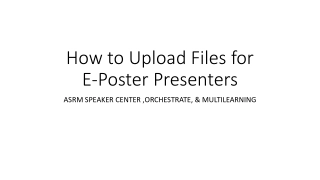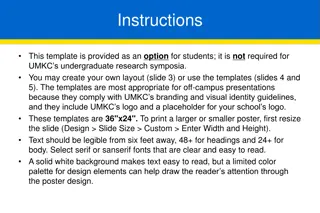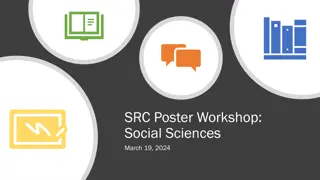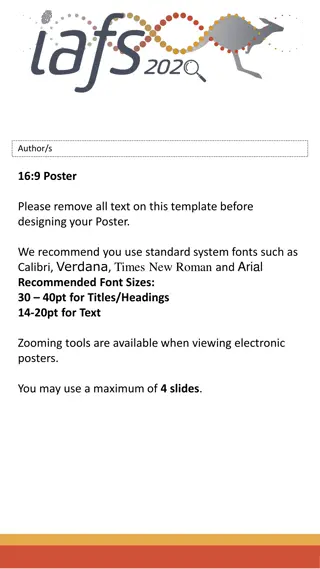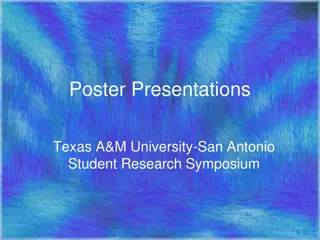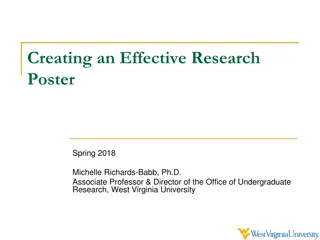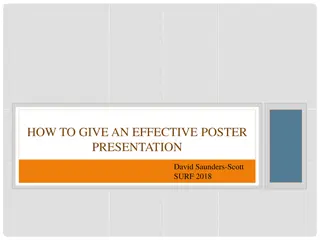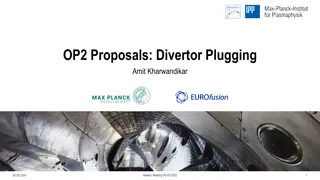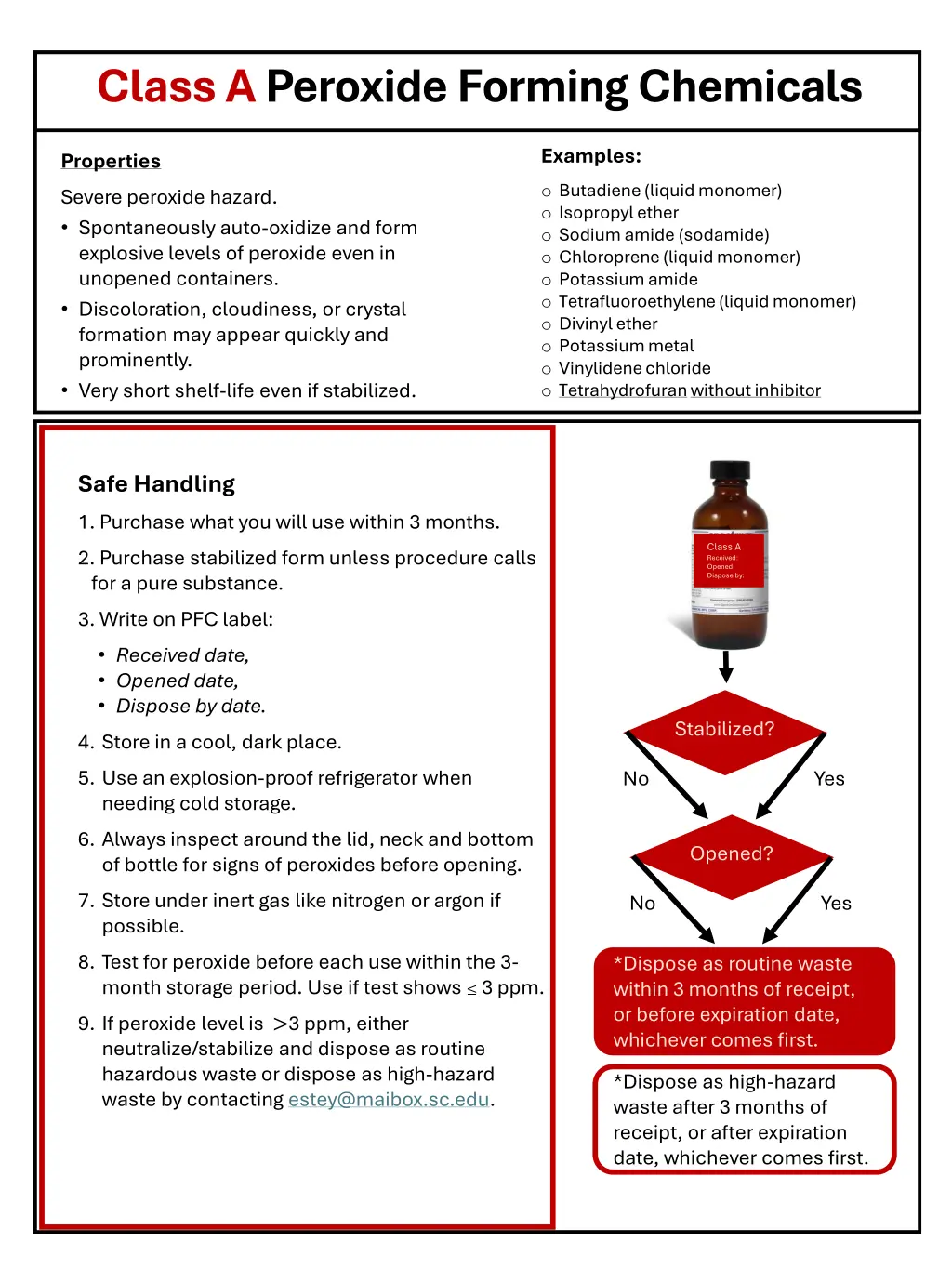
Peroxide-Forming Chemicals Handling Guidelines
Safely handle peroxide-forming chemicals by following specific guidelines to prevent hazardous situations, including storage recommendations, testing procedures, and disposal protocols for different classes of chemicals.
Download Presentation

Please find below an Image/Link to download the presentation.
The content on the website is provided AS IS for your information and personal use only. It may not be sold, licensed, or shared on other websites without obtaining consent from the author. If you encounter any issues during the download, it is possible that the publisher has removed the file from their server.
You are allowed to download the files provided on this website for personal or commercial use, subject to the condition that they are used lawfully. All files are the property of their respective owners.
The content on the website is provided AS IS for your information and personal use only. It may not be sold, licensed, or shared on other websites without obtaining consent from the author.
E N D
Presentation Transcript
Class APeroxide Forming Chemicals Examples: Properties Severe peroxide hazard. Spontaneously auto-oxidize and form explosive levels of peroxide even in unopened containers. Discoloration, cloudiness, or crystal formation may appear quickly and prominently. Very short shelf-life even if stabilized. o Butadiene (liquid monomer) o Isopropyl ether o Sodium amide (sodamide) o Chloroprene (liquid monomer) o Potassium amide o Tetrafluoroethylene (liquid monomer) o Divinyl ether o Potassium metal o Vinylidene chloride o Tetrahydrofuran without inhibitor Safe Handling 1. Purchase what you will use within 3 months. 2. Purchase stabilized form unless procedure calls for a pure substance. 3. Write on PFC label: Received date, Opened date, Dispose by date. 4. Store in a cool, dark place. 5. Use an explosion-proof refrigerator when needing cold storage. 6. Always inspect around the lid, neck and bottom of bottle for signs of peroxides before opening. 7. Store under inert gas like nitrogen or argon if possible. 8. Test for peroxide before each use within the 3- month storage period. Use if test shows 3 ppm. 9. If peroxide level is >3 ppm, either neutralize/stabilize and dispose as routine hazardous waste or dispose as high-hazard waste by contacting estey@maibox.sc.edu. Class A Received: Opened: Dispose by: Stabilized? No Yes Opened? No Yes *Dispose as routine waste within 3 months of receipt, or before expiration date, whichever comes first. *Dispose as high-hazard waste after 3 months of receipt, or after expiration date, whichever comes first. estey@maibox.sc.edu
Class B Peroxide Forming Chemicals No peroxide testing* Examples: o Acetal o Cumene o Cyclohexene o Cyclooctene o Cyclopentene o Diaacetylene o Dicyclopentadiene o Diethylene glycol dimethyl o ether (diglyme) o Diethyl ether Properties: Peroxide forms on concentration. Peroxide formation through autooxidation is slower. Distillation/evaporation will accelerate peroxide formation and concentrate the peroxides, which can explode with heat, spark, or shock. o Dioxane (p-dioxane) e.g. 1,4 dioxane o Ethylene glycol dimethyl o ether (glyme) o Furan o Methyl acetylene o Methyl cyclopentane o Methyl-isobutyl ketone o Tetrahydrofuran o Tetrahydronaphthalene o Vinyl ethers Safe Handling 1. *Aways test for peroxide before each use in procedures that involve heating, distillation, or evaporation. 10 ppm is generally safe, but do not evaporate to dryness! 2. Purchase what you will use within 12 months. 3. Purchase stabilized form unless procedure calls for a pure substance. 3. Write on PFC label: Received date, Opened date, Dispose by date. 4. Store in a cool, dark place. 5. Use an explosion-proof refrigerator when needing cold storage. 6. Always inspect around the lid, neck and bottom of bottle for signs of peroxides before opening. 7. Dispose as routine hazardous waste within 12 months of receipt (unopened bottle), within 6 months of opening, or before expiration date, whichever comes first. 8. Dispose as high-hazard waste all containers kept after the dates in #7. Class B Received: Opened: Dispose by: Stabilized? No Yes Treat as Class A Opened? No Dispose as routine hazardous waste within 12 months of receipt or before expiration date, whichever comes first. Yes Dispose as routine hazardous waste within 6 months of opening or before expiration date, whichever comes first.
Class B Peroxide Forming Chemicals With peroxide testing* Examples: o Acetal o Cumene o Cyclohexene o Cyclooctene o Cyclopentene o Diaacetylene o Dicyclopentadiene o Diethylene glycol dimethyl o ether (diglyme) o Diethyl ether Properties: Peroxide forms on concentration. Peroxide formation through autooxidation is slower. Distillation/evaporation will accelerate peroxide formation and concentrate the peroxides, which can explode with heat, spark, or shock. o Dioxane (p-dioxane) e.g. 1,4 dioxane o Ethylene glycol dimethyl o ether (glyme) o Furan o Methyl acetylene o Methyl cyclopentane o Methyl-isobutyl ketone o Tetrahydrofuran o Tetrahydronaphthalene o Vinyl ethers Safe Handling 1. *Aways test for peroxide before each use in procedures that involve heating, distillation, or evaporation. Peroxide level 10 ppm is generally safe, but do not evaporate to dryness! 2. Test Frequency Always test for peroxide before using in procedures that involve heating, in addition to periodic tests. If opened within 3 mos. test for peroxides @r 6th month of opening, every 3 months thereafter. If opened within 4-6 mos., test for peroxides @ 3rd month of opening, then every 3 mos. thereafter If opened within 7-11 mos., test for peroxide after opening, then every 3 mos. thereafter. 3. Peroxide Level Class B Received: Opened: Dispose by: Stabilized? No Yes Treat as Class A Opened? No o 3 ppm: safe to use for any experiment. o >3-10 ppm: generally safe to use in experiments but observe extreme caution if procedure involves heating, distillation, evaporation, or mechanical stress. Do not evaporate to dryness! Dispose as routine hazardous waste within 12 months of receipt or before expiration date, whichever comes first. Yes o >10-30 ppm: either neutralize peroxides to 1 ppm , add stabilizer, then dispose as routine hazardous waste or dispose as high-hazard waste by contacting estey@mailbox.sc.edu. Disposal schedule is based on peroxide test results and whether neutralization/stabilization is performed before requesting waste pickup (Refer to Safe Handling). estey@mailbox.sc.edu o >30 ppm: Segregate and label container as high- hazard waste. Contact estey@mailbox.sc.edu for disposal. estey@mailbox.sc.edu
Class C Peroxide Forming Chemicals No peroxide testing* Properties Internal peroxide formation initiates polymerization. Discoloration, cloudiness, and crystal formation accompanied by increased viscosity or gel formation. Heating can detonate peroxides and potentially lead to violent polymerization. Examples: o Vinyl acetylene o Chlorobutadiene o Vinyl chloride (gas) o Chlorotrifluoroethylene (gas) o Vinyl pyridine o Methyl methacrylate o Vinylidine chloride o Acrylic acid o Styrene o Acrylonitrile o Tetrafluoroethylene (gas) o Butadiene (gas) o Vinyl acetate o Chloroprene Safe Handling 1. *Aways test for peroxide before each use in procedures that involve heating, distillation, or evaporation. 10 ppm is generally safe, but do not evaporate to dryness! 2. Purchase what you will use within 12 months. 3. Purchase stabilized form unless procedure calls for a pure substance. 3. Write on PFC label: Received date, Opened date, Dispose by date. 4. Store in a cool, dark place. 5. Use an explosion-proof refrigerator when needing cold storage. 6. Always inspect around the lid, neck and bottom of bottle for signs of peroxides or polymerization before opening. 7. Dispose as routine hazardous waste within 12 months of receipt (unopened bottle), within 6 months of opening, or before expiration date, whichever comes first. 8. Dispose as high-hazard waste all containers kept after the dates in #7 or when polymerization occur. Class C Received: Opened: Dispose by: No Stabilized? Very unlikely sold commercially but in rare occasions, use or dispose within 24 hours Yes Opened? No Dispose as routine hazardous waste within 12 months of receipt or before expiration date, whichever comes first. Yes Dispose as routine hazardous waste within 6 months of opening or before expiration date, whichever comes first.
Class C Peroxide Forming Chemicals With peroxide testing* Properties Internal peroxide formation initiates polymerization. Discoloration, cloudiness, and crystal formation accompanied by increased viscosity or gel formation. Heating can detonate peroxides and potentially lead to violent polymerization. Examples: o Vinyl acetylene o Chlorobutadiene o Vinyl chloride (gas) o Chlorotrifluoroethylene (gas) o Vinyl pyridine o Methyl methacrylate o Vinylidiene chloride o Acrylic acid o Styrene o Acrylonitrile o Tetrafluoroethylene (gas) o Butadiene (gas) o Vinyl acetate o Chloroprene Safe Handling 1. *Aways test for peroxide before each use in procedures that involve heating, distillation, or evaporation. Peroxide level 10 ppm is generally safe, but do not evaporate to dryness! 2. Test Frequency Always test for peroxide before using in procedures that involve heating, in addition to periodic tests. If opened within 3 mos. test for peroxides @ 6th month of opening, every 3 months thereafter. If opened within 4-6 mos., test for peroxides @ 3rd month of opening, then every 3 mos. Thereafter. If opened within 7-11 mos., test for peroxide after opening, then every 3 mos. thereafter. 3. Peroxide Level Class B Received: Opened: Dispose by: Very unlikely sold commercially but in rare occasions, use or dispose within 24 hours! Stabilized? No Yes Opened? No o 3 ppm: safe to use for any experiment. o >3-10 ppm: generally safe to use in experiments but observe extreme caution if procedure involves heating, distillation, evaporation, or mechanical stress. Do not evaporate to dryness! Dispose as routine hazardous waste within 12 months of receipt or before expiration date, whichever comes first. Yes o >10-30 ppm: either neutralize peroxides to 1 ppm , add stabilizer, then dispose as routine hazardous waste or dispose as high-hazard waste by contacting estey@mailbox.sc.edu. Disposal schedule is based on peroxide test results and whether neutralization/stabilization is performed before requesting waste pickup (Refer to Safe Handling). estey@mailbox.sc.edu o >30 ppm: Segregate and label container as high- hazard waste. Contact estey@mailbox.sc.edu for disposal. estey@mailbox.sc.edu
Class D Peroxide Forming Chemicals Examples: Properties: Peroxide forms under certain conditions. Peroxide formation is triggered by extreme or prolonged conditions like heat, light, and long-term air exposure, catalysts/contamination, and inhibitor depletion. o 2-propanol o Ethylene glycol o Ethanol o 2-butanol o Propylene glycol o 1-octene o 1-pentene o Acrolein o Allyl ethyl ether o Benzyl n-butyl ether o 2 butenal o 1, 3, 5 trioxane o Dibenzyl ether o Dimethoxy methane o Dipropargyl ether o Dipropyl ether o Ethyl vinyl ether o Sodium ethoxy acetylide Safe Handling 1. Do not store indefinitely! 2. Aways test for peroxide before each use in procedures that involve heating, distillation, or evaporation. 10 ppm is generally safe, but do not evaporate to dryness! 3. Purchase what you will use within 2 years. 4. Purchase stabilized form unless procedure calls for a pure substance. 3. Write on PFC label: Received date, Opened date, Dispose by date. 4. Store in a cool, dark place. 5. Use an explosion-proof refrigerator when needing cold storage. 6. Always inspect around the lid, neck and bottom of bottle for signs of peroxides before opening. 7. Dispose as routine hazardous waste within 2 years of receipt (unopened bottle), or before expiration date, whichever comes first. 8. Dispose as high-hazard waste all containers kept after the dates in #7 or when peroxide formed is not neutralized before requesting pickup. Class B Received: Opened: Dispose by: Opened? No Dispose as routine hazardous waste within 24 months of receipt or before expiration date, whichever comes first. Yes Dispose as routine hazardous waste within 2 years of receipt, or before expiration date, whichever comes first. When peroxide level reaches 30 ppm, neutralize to <1 ppm peroxide, before requesting pickup as routine hazardous waste.

